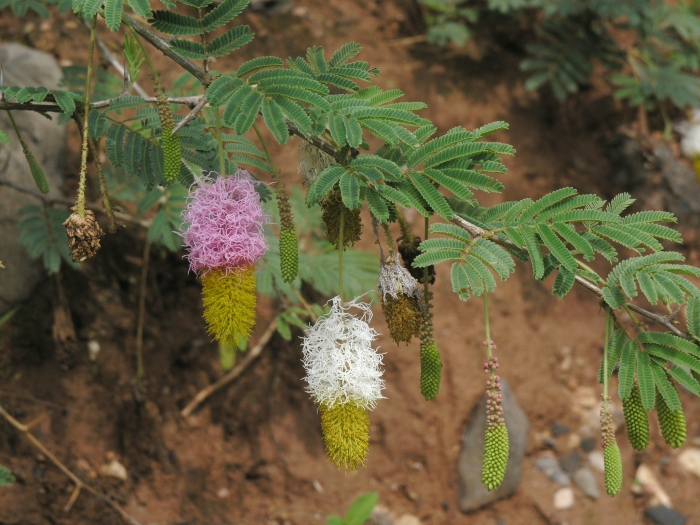Sicklebush
(Dichrostachys cinerea)
Sicklebush (Dichrostachys cinerea)
/
/

Oleg Kosterin
CC BY 4.0
Image By:
Oleg Kosterin
Recorded By:
Copyright:
CC BY 4.0
Copyright Notice:
Photo by: Oleg Kosterin | License Type: CC BY 4.0 | License URL: http://creativecommons.org/licenses/by/4.0/ | Rights Holder: Oleg Kosterin | Publisher: iNaturalist | Date Created: 2012-08-01T13:55:05-07:00 |
























Estimated Native Range
Summary
Dichrostachys cinerea, commonly known as sicklebush, bell mimosa, Chinese lantern tree, or Kalahari Christmas tree, is a deciduous shrub or small tree native to open woodlands, savannas, and thornvelds of Africa, the Indian subcontinent, and New Guinea. It typically grows up to 23 feet (7 meters) tall and is characterized by its bipinnately compound leaves and striking bicolored cylindrical spikes of fragrant flowers that bloom in summer, resembling Chinese lanterns. The flowers are yellow at the base and pink at the tips, creating a two-toned effect that is quite showy. The bark is rough and fissured, adding to its ornamental value.
Sicklebush is valued for its distinctive flowers, which attract pollinators, and its ability to thrive in poor soils with minimal water, making it suitable for xeriscaping. It is used in traditional medicine and as a forage plant in its native range. In cultivation, it requires full sun, well-drained soils, and can tolerate drought once established. However, it can become a problematic invasive species outside its native range, particularly in Cuba where it affects agricultural land. Gardeners should be cautious about its potential to spread aggressively and should consult local regulations before planting.CC BY-SA 4.0
Sicklebush is valued for its distinctive flowers, which attract pollinators, and its ability to thrive in poor soils with minimal water, making it suitable for xeriscaping. It is used in traditional medicine and as a forage plant in its native range. In cultivation, it requires full sun, well-drained soils, and can tolerate drought once established. However, it can become a problematic invasive species outside its native range, particularly in Cuba where it affects agricultural land. Gardeners should be cautious about its potential to spread aggressively and should consult local regulations before planting.CC BY-SA 4.0
Plant Description
- Plant Type: Shrub, Tree
- Height: 20-23 feet
- Width: 5-20 feet
- Growth Rate: Slow, Moderate
- Flower Color: Pink, Purple, Yellow
- Flowering Season: Spring, Summer
- Leaf Retention: Deciduous
Growth Requirements
- Sun: Full Sun
- Water: Low
- Drainage: Medium
Common Uses
Drought Tolerant, Erosion Control, Showy Flowers
Natural Habitat
native to open woodlands, savannas, and thornvelds of Africa, the Indian subcontinent, and New Guinea
Other Names
Common Names: Sicklebush, Kalahari Christmas Tree, Kalahari-Weihnachtsbaum, Acacia Saint Domingue, El Marabu, Kéké, Marabou-Thorn, Chinese Lantern Tree
Scientific Names: , Dichrostachys cinerea, Acacia cinerea, Cailliea cinerea, Cailliea cinerea, Desmanthus cinereus, Dichrostachys cinerea subsp. lugardae, Dichrostachys cinerea subsp. paucijuga, Dichrostachys lugardae, Dichrostachys platycarpa
GBIF Accepted Name: